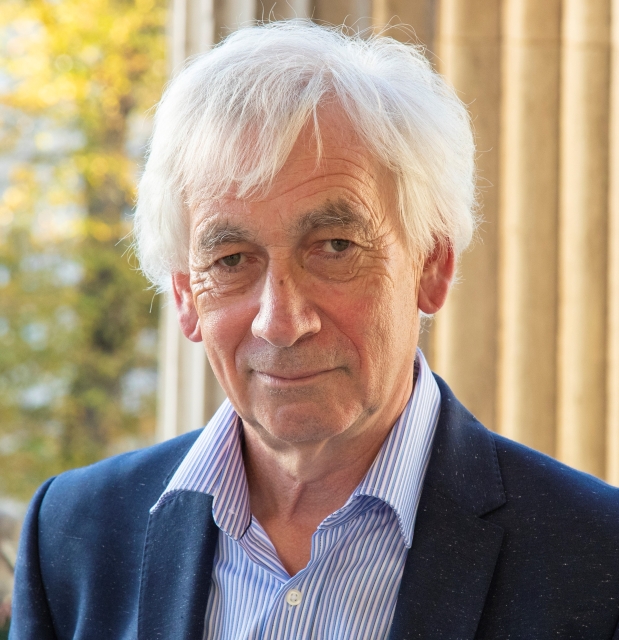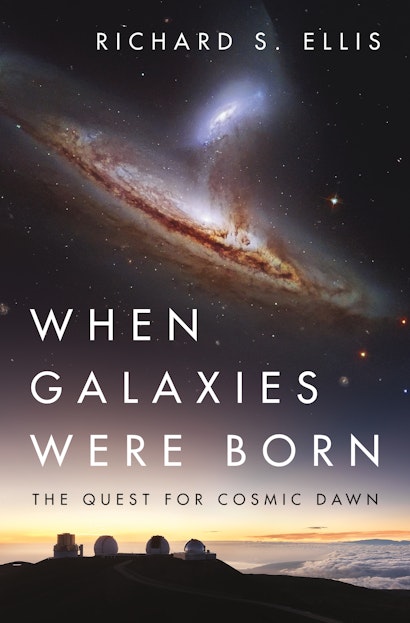Astronomers are like time travelers, scanning the night sky for the outermost galaxies that first came into being when our universe was a mere fraction of its present age. When Galaxies Were Born is Richard Ellis’s firsthand account of how a pioneering generation of scientists harnessed the world’s largest telescopes to decipher the history of the universe and witness cosmic dawn, the time when starlight first bathed the cosmos and galaxies emerged from darkness.
Can you describe your new book; what it’s about and how it came to be written?
RSE: My book describes the adventure to trace the history of galaxies all the way back to when they first emerged from darkness when the universe was barely 2% of its present age. It’s a remarkable story that follows the development of ever larger telescopes, both on the ground and in space, made possible by advances in engineering and technology. As an observational astronomer who has witnessed this dramatic progress during my career, I aim to provide an insider’s view of how this progress occurred, how the discoveries were made as well as introducing many of the colourful characters responsible. Observing the night sky from a remote mountaintop is a source of inspiration to many and my book is well-illustrated to convey this aspect of the adventure. The project began as a partnership with a professional photographer interested in exhibiting his photographs of the telescopes I have used during my career. We toured the world to accomplish this just before lockdown and I decided to accompany my story with his striking photographs.
Your book is sub-titled the Quest for Cosmic Dawn. What exactly is Cosmic Dawn and why is it considered important?
RSE: “Cosmic dawn” refers to the time when galaxies and stars first began to shine in the early universe. Although the universe began with a Big Bang 13.8 billion years ago, astronomers believe the first stars and galaxies formed about 200 million years later. Prior to this time the universe was dark. A key question is whether we can look sufficiently far back in time to directly witness this moment when the universe was first bathed in starlight. Since we are, ourselves, made from material synthesised in stars, this quest can rightly be regarded as the search for our own origins.
Can you explain how it’s possible for astronomers to directly witness the past? It seems a remarkable feat.
RSE: Astronomers are fortunate to be able to time travel! When we look at the Sun we see it as it was 8 minutes ago; that’s the light travel time from the Sun to the earth. The nearest star is seen as it was 4 years ago for the same reason. But the situation is transformed when we use a large telescope capable of probing back billions of years to when the universe was in its infancy. While we don’t live long enough to witness the evolution of any individual galaxy, by studying populations seen at various “look-back times” we can piece together the history of our universe from the distant past to the present.
We’ve heard a lot about the James Webb Space Telescope? What was your involvement in this project, what is so special about it and what do the first results indicate?
RSE: The James Webb Space Telescope (JWST), launched in December 2021, represents the latest chapter in our quest to witness cosmic dawn. Soon after the repair of the Hubble Space Telescope in 1993, I served as the only European-based astronomer on a US panel that developed the science case for this remarkable facility. As with many ambitious scientific instruments, it had a rocky path to completion and was often threatened with cancellation due to cost overruns. As well as being a larger, more powerful facility than the Hubble Space Telescope, its most important feature is that it provides access to the infrared spectral region where early galaxies can be observed. JWST has been a truly ambitious venture! For example the six and half meter primary mirror is comprised of 18 hexagonal segments that had to be folded in order to fit into the nose cone of the rocket that propelled it beyond the Moon. However, the flawless launch and the subsequent deployment was a huge success and the first images now emerging are truly breathtaking.
When you look back over your career, what would you say were the major surprises and most gratifying moments? And the disappointments?
RSE: Making a discovery during the night at a large telescope is the best moment in any observational astronomer’s life. It’s truly exhilarating and particularly when it’s a surprise rather than a simple vindication of one’s earlier hypothesis. Of course big discoveries don’t happen every observing run and there are many disappointments and frustrations along the way. These include cloudy nights and technical failures at the observatory - traveling half way round the world to return empty handed is terribly debilitating. Also, as my book describes, the subject is highly competitive and there’s often a rival team that beats one to an important result. But there’s never a dull moment and, as far as I’m concerned, I have the best job in the world!
Most ground-based telescopes can now be operated over the internet but you mention that much of the romance in being an astronomers is then lost. Can you elaborate on this?
RSE: I suppose I am a romantic at heart! I still get a thrill from watching the sunset from an observatory in the Chilean desert or from the summit of Mauna Kea in Hawaii prior to working all night chasing a distant galaxy! As I describe in my book, the availability of the high speed internet has made observing with a large telescope from the comfort of home a reality. While such remote observing is more cost-effective and respectful of the climatic impact of long-distant travel, I can’t help thinking something is lost. Observing with a large telescope becomes just like another day in the office.
Take us back to your childhood. What made you realise you wanted to become an astronomer? Was it an easy path to follow?
RSE: I decided to become an astronomer when I was only six years old and never waivered in that ambition. I picked up a children’s book in the public library which made me realise there was a universe above my head waiting to be explored. As I describe in my book, there were many professional and other hurdles along the way before I got to walk into the dome of a large telescope and conduct my own observations. I’ve been extremely fortunate to live through a time when there’s been so much progress in my field and I hope this is accurately conveyed in my book.
During your career you have moved countries several times and used a large variety of telescopes along the way. What have you gained by working in so many places in your career?
RSE: It’s true that I have moved institutions more than most astronomers, working in Britain, the United States and Germany, gaining access to telescopes in Australia, the Canary Islands, Chile, California and Hawaii. It’s been refreshing to learn how to do science in communities with different cultures as well as to master the instrumentation on a variety of different telescopes. I think if one stays at the same place there’s a danger of complacency. In each move I had to reinvent myself, demonstrate my ability to my new colleagues and I think this has kept me in good shape!
Are we close to witnessing Cosmic Dawn? If so, then what?
RSE: I do hope so; it’s been a long haul as described in my book! Nonetheless there still remain big challenges. Will we recognise cosmic dawn when we see it? It could be like looking for a needle in a haystack since a first-generation galaxy free from chemical elements synthesised in stars may be very quickly polluted by the first supernova explosions. But I’m an optimist at heart and the first datasets emerging from the James Webb Space Telescope are very promising!
Richard S. Ellis is professor of astrophysics at University College London and a world-renowned observational astronomer who has made numerous discoveries about the nature and evolution of the universe. He lives in Cambridge, UK.

